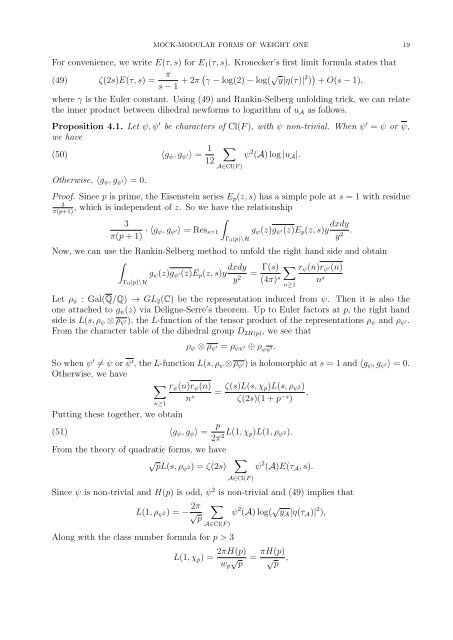Mock-modular forms of weight one - UCLA Department of Mathematics
Mock-modular forms of weight one - UCLA Department of Mathematics
Mock-modular forms of weight one - UCLA Department of Mathematics
Create successful ePaper yourself
Turn your PDF publications into a flip-book with our unique Google optimized e-Paper software.
MOCK-MODULAR FORMS OF WEIGHT ONE 19<br />
For convenience, we write E(τ, s) for E 1 (τ, s). Kr<strong>one</strong>cker’s first limit formula states that<br />
(49) ζ(2s)E(τ, s) = π<br />
s − 1 + 2π ( γ − log(2) − log( √ y|η(τ)| 2 ) ) + O(s − 1),<br />
where γ is the Euler constant. Using (49) and Rankin-Selberg unfolding trick, we can relate<br />
the inner product between dihedral new<strong>forms</strong> to logarithm <strong>of</strong> u A as follows.<br />
Proposition 4.1. Let ψ, ψ ′ be characters <strong>of</strong> Cl(F ), with ψ non-trivial. When ψ ′ = ψ or ψ,<br />
we have<br />
(50) 〈g ψ , g ψ ′〉 = 1 ∑<br />
ψ 2 (A) log |u A |.<br />
12<br />
Otherwise, 〈g ψ , g ψ ′〉 = 0.<br />
A∈Cl(F )<br />
Pro<strong>of</strong>. Since p is prime, the Eisenstein series E p (z, s) has a simple pole at s = 1 with residue<br />
, which is independent <strong>of</strong> z. So we have the relationship<br />
3<br />
π(p+1)<br />
3<br />
π(p + 1) · 〈g ψ, g ψ ′〉 = Res s=1 g ψ (z)g ψ ′(z)E p (z, s)y<br />
∫Γ dxdy .<br />
0 (p)\H<br />
y 2<br />
Now, we can use the Rankin-Selberg method to unfold the right hand side and obtain<br />
∫<br />
g ψ (z)g ψ ′(z)E p (z, s)y dxdy = Γ(s) ∑ r ψ (n)r ψ ′(n)<br />
y 2 (4π) s n s<br />
Γ 0 (p)\H<br />
Let ρ ψ : Gal(Q/Q) → GL 2 (C) be the representation induced from ψ. Then it is also the<br />
<strong>one</strong> attached to g ψ (z) via Deligne-Serre’s theorem. Up to Euler factors at p, the right hand<br />
side is L(s, ρ ψ ⊗ ρ ψ ′), the L-function <strong>of</strong> the tensor product <strong>of</strong> the representations ρ ψ and ρ ψ ′.<br />
From the character table <strong>of</strong> the dihedral group D 2H(p) , we see that<br />
ρ ψ ⊗ ρ ψ ′ = ρ ψψ ′ ⊕ ρ ψψ ′.<br />
So when ψ ′ ≠ ψ or ψ ′ , the L-function L(s, ρ ψ ⊗ρ ψ ′) is holomorphic at s = 1 and 〈g ψ , g ψ ′〉 = 0.<br />
Otherwise, we have<br />
∑ r ψ (n)r ψ (n)<br />
= ζ(s)L(s, χ p)L(s, ρ ψ 2)<br />
,<br />
n s ζ(2s)(1 + p −s )<br />
n≥1<br />
Putting these together, we obtain<br />
(51) 〈g ψ , g ψ 〉 = p<br />
2π L(1, χ p)L(1, ρ 2 ψ 2).<br />
From the theory <strong>of</strong> quadratic <strong>forms</strong>, we have<br />
√ ∑<br />
pL(s, ρψ 2) = ζ(2s) ψ 2 (A)E(τ A , s).<br />
A∈Cl(F )<br />
Since ψ is non-trivial and H(p) is odd, ψ 2 is non-trivial and (49) implies that<br />
L(1, ρ ψ 2) = −√ 2π ∑<br />
ψ 2 (A) log( √ y A |η(τ A )| 2 ),<br />
p<br />
A∈Cl(F )<br />
Along with the class number formula for p > 3<br />
L(1, χ p ) = 2πH(p)<br />
w p<br />
√ p<br />
n≥1<br />
= πH(p) √ p<br />
,
















